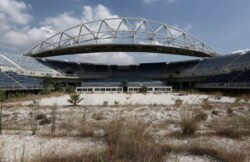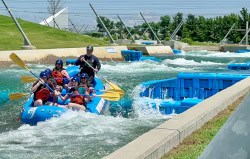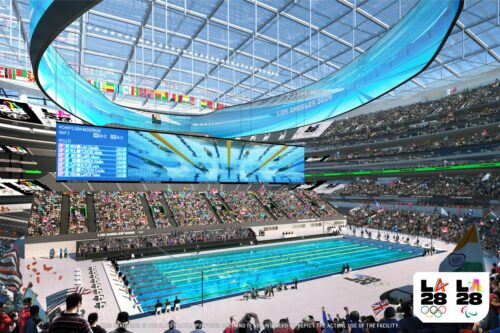Four years from the start of the Summer Olympic Games in Los Angeles, the list of venues was announced with swimming moved to the largest swimming venue in the history of the Olympics and two events being held halfway across the country. Those and other moves are designed to help reduce the cost of staging the biggest sporting event in the world, an ever increasing requirement of the International Olympic Committee for future games. The question is if these moves signal the beginning of the end of the Olympic Games as we’ve known them or a new approach that will yield even better games in the future.

The cost of staging the Olympic Games, both Summer and Winter, have been an issue of controversy over the past few decades, sometimes crippling the budgets of cities and countries to pay for the massive venues and operating costs to keep the Games secure. In several cases, venues built just for the Games now sit abandoned and decaying. In Athens, several of the venues built specifically for the 2004 Summer Olympic Games have no meaningful purpose in the country due to no real post-Games competition, volleyball being a great example.
The most expensive Olympic Games ever staged was the 2014 Winter Olympic Games in Sochi, Russia. These games were designed to showcase Russia’s seaside resort to the world, promoted by Vladimir Putin. There is no doubt that he personally had a hand in selecting the site since it sits close his palace on the Black Sea. At a cost of over $50 billion, it was fraught with corruption, poor quality facilities, and tremendous cost overruns. That’s when the IOC decided the Games would not be sustainable if future Games had to meet or exceed such expectations.
In 2018 at their meeting in Pyeongchang, the IOC adopted a new approach to bidding for and implementing future games called “The New Norm.” The goal was to streamline the staging of the Olympic Games and reduce staffing in the first 3 years to prevent creation of a bloated staff with no real duties in those early years. Staffing would ramp up starting in year 4 and grow leading to the Games. A focus on existing facilities would help reduce the cost of infrastructure and any new construction must have a committed purpose after the Games. The IOC would build its own infrastructure that could be used from Games to Games, eliminating the need for new computer and broadcast systems.
This brings us to LA 2028 which just announced its updated Games Plan, resulting in a shift in some venues from the original bid and a start of a new innovative approach to the Games. Following the success of the swimming trials in Indianapolis, LA has decided to leverage Sofi Stadium for swimming, creating a media buzz with the largest swimming venue in Olympic history and opening tickets to what is arguably the hottest ticket in town during the Summer Games to more people. Utilizing large video boards, spectators will be able to get the Olympic experience and still enjoy the competition.
The new plan recognizes that a lot has changed since LA won the bid and there is no reason to bind themselves to an old plan when things could be better. From the release, “LA28’s previous venue plan was developed in 2017 when the City of Los Angeles was bidding for the Games. Since then, several new state-of-the-art stadiums and arenas have become available, a previously assigned venue has become unavailable, new sports have been added to the 2028 program, and the International Olympic Committee (IOC) developed new policy to encourage Games organizers to prioritize using existing or temporary venues, even if they are located outside of the Host City.”

To accommodate these changes, the traditional Olympic schedule will shift with track and field held the first week of the Games and swimming moved to the second week to allow the LOC time to reset Sofi Stadium from the Opening Ceremonies to a swimming venue in a half field configuration. Diving will use the same pool that was used in the 1932 Summer Games and the minor upgrades to the facility will serve the community for decades to come.

One venue challenge for LA was providing a venue for canoe slalom. Surprisingly, with all the rivers and streams in California, there is no competitive venue for the sport anywhere in the West. Instead of spending millions of dollars to build a venue that may or may not have use after the Games, LA looked to Oklahoma City where a world-class canoe slalom facility had been built in 2016 called RIVERSPORT Rapids. In doing so, LA saved money and brought the Olympics to a city that probably would never be considered an Olympic destination.
Having already moved a sport to OKC, LA decided to go a step further and shift softball to the premier softball facility in the nation at Devon Park, the annual home of the Women’s College World Series. Once again, LA saves in venue costs and now Oklahoma City would enjoy the spotlight of the world during the Games as well as an unexpected jolt of tourist dollars from the Games. Both moves have been approved by the sports federations and the IOC Executive Board. They are still pending approval from the City of LA, but it would be ridiculous to think they would oppose such moves and burden the Games with the costs of building facilities.
These changes do break the tradition that the Games must be staged within proximity of the bidding city, but that tradition had been broken in prior Games. Granted, this would be probably the most extreme of such a situation with OKC being over 1,300 miles from LA. But in this day and age of technology, it wouldn’t really seem like they were that far away. What it does do is give countries and cities the ability to explore options for some sports that might not have quality venues in the bidding cities. It keeps the costs of the Games down and extends the Olympic experience outside the host city, letting more people get their five ring fix.
LA 2028 will be a new style of Olympics, but one I think will help build a stronger Olympic experience for the future.
